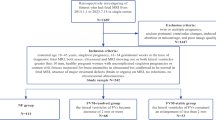Abstract
Introduction
The proper function of the fetal heart is indispensable for the fetal development and the normal fetal growth. For prenatal medicine, Doppler sonography offers the possibility of a non-invasive method to examine the fetal cardiovascular function under normal and pathological circumstances. The role of the Doppler sonography is to identify those fetuses who have a high risk factor for developing a pre- or intrapartual asphyxia and therefore have to be delivered promptly. This study aimed at evaluating the clinical value of the intracardiac Doppler sonography (IDS) and at scrutinizing its usefulness during the supervision of the pregnancy of intrauterine growth restricted (IUGR) fetuses.
Materials and methods
In a prospective research at the Medical School of Hanover, fetal IDS was applied to 174 pregnant women between the 21 and 37 weeks of gestation (WG). The e-wave and the a-wave, the E/A ratio, and the TVI (time velocity integral) were measured at the atrioventricular (AV) valves. The PV (peak velocity) as well as the TVI were determined at both the aortic and the pulmonary valve. Normal range curves were compiled for all measured parameters.
Results
Alongside a control group with untroubled gravidity, which consisted of 153 patients, IUGR fetuses, who formed a collective of 21 patients, were Doppler sonographically examined.
While the gestational age advanced, an increase of both the e-wave and the a-wave above the AV-valves could be ascertained, which lead to an E/A ratio <1. Above the semilunar valves there was indicated a slight steady increase of the TPV, the PV as well as the TVI. Normal range curves, which largely correspond to those described in the literature, were compiled for the collective of the pregnancies without pathological findings (n = 153). In comparison to the standard collective, there were no significant differences from the collective of the growth restricted fetuses (n = 21).
Conclusion
A temporal informational advantage of pathological intracardiac Doppler values for high risk pregnancies (IUGR) could not be retraced in the examined collective.
Doppler sonography traces acute and chronic deficits, which are indicated by hemodynamic changes of the fetus’s blood supply. The clinical importance of IDS as regards dystrophic fetuses has to be ascertained in continuative studies: In the stage of compensatory placental insufficiency (IUGR, arterial Doppler without ARED-flow, venous Doppler without pathological findings) the IDS cannot provide an informational advantage. Contrastingly, the diagnostic potential of the IDS as a screening method of fetal cardiac insufficiency during decompensative placental insufficiency (IUGR, arterial Doppler with ARED-flow, venous Doppler normal or pathological) remains indistinct and should therefore be prospectively evaluated within this high risk group and contrastingly compared to the significance of the venous Doppler sonography (informational advantage?).






Similar content being viewed by others
References
Arduini D, Rizzo G, Romanici C (1995) Fetal cardiac function, vol 1. The Parthenon Publishing Group, New York, London, pp 33–39
Hecher K, Hackelöer BJ (1997) Cardiotocogramm compared to Doppler investigation of the fetal ciculation in premature growth-retarded fetus. Ultrasound Obstet Gynecol 9:152–161
Arabin B, Saling E (1987) Die “Sparschaltung” des fetalen Kreislaufs dargestellt anhand von eigenen quantitativen Doppler-Blutflussparametern. Z Geburtshilfe Perinatol 191:213–218
Schmidt W, Rühle W (1989) Pathologische Doppler-Flow-Untersuchungen—Korrelationen zu pathologischen CTGs. Arch Gynecol Obstet 245:86–87
Mäkikallio K, Vuolteenaho O, Jouppila P, Räsänen J (2000) Association of severe placental insuffiency and systemic venous blood pressure rise in the fetus with increased neonatl cardiac troponin t levels. Am J Obstet Gynecol 183:726–731
Ritter S, Jörn H, Rath W (2002) Doppler-Sonographie des Ductus venosus: Messung, Evaluation und derzeitiger klinischer Stellenwert. Z Geburtsh Neonatol 206:1–8
Chaoui R, Heling K, Taddei F, Bollmann R (2001) Fetal atrioventricular blood flow velocity in the 2nd half of pregnancy: a Doppler echocardiographic study. Z Geburtsh Neonatol 13–20
Rizzo G, Arduini D, Romanini C, Mancuso S (1988) Doppler echocardiographic assessment of atrioventricular velocity waveforms in normal and small for gestational age fetuses. Br J Obstet Gynaecol 95:65–69
Trudinger BJ, Giles WB, Cook CM (1985) Uteroplacental blood flow velocity waveforms in normal and complicated pregnancy. Br J Obstet Gynecol 92:39–45
Rizzo G, Arduini D, Romanini C, Manesco S (1990) Doppler echocardiographic evaluation of time to peak velocity in the aorta and pulmonary artery of small for gestational age fetuses. Br J Obstet Gynaecol 97:603–607
Kenny J, Plappert T, Saltzman D, Cartire M, Zollars L, Leatherman G, St. John Sutton M (1986) Changes in intracardiac blood flow velocities and right and left ventricular stroke volumes with gestational age in the normal human fetus: a prospective Doppler echocardiographic study. Circulation 74:1208–1216
Groenenberg IAL, Wladimiroff JW, Hop WCJ (1989) Fetal cardiac and peripheral arterial flow velocity waveforms in intrauterine growth retardation. Circulation 80:1711–1117
Rizzo G, Arduini D (1991) Fetal cardiac function in intrauterine growth retardation. Am J Obstet Gynecol 165:876–882
Author information
Authors and Affiliations
Corresponding author
Rights and permissions
About this article
Cite this article
Staboulidou, I., Soergel, P., Schmidt, P. et al. The significance of intracardiac Doppler sonography in terms of fetal growth retardation. Arch Gynecol Obstet 276, 35–42 (2007). https://doi.org/10.1007/s00404-006-0302-4
Received:
Accepted:
Published:
Issue Date:
DOI: https://doi.org/10.1007/s00404-006-0302-4




